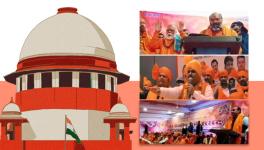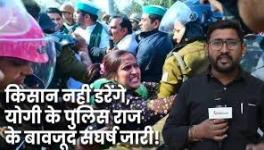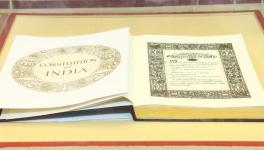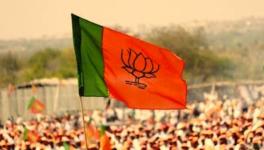Why a Crackdown on Shah Jamal Protesters is Unjust
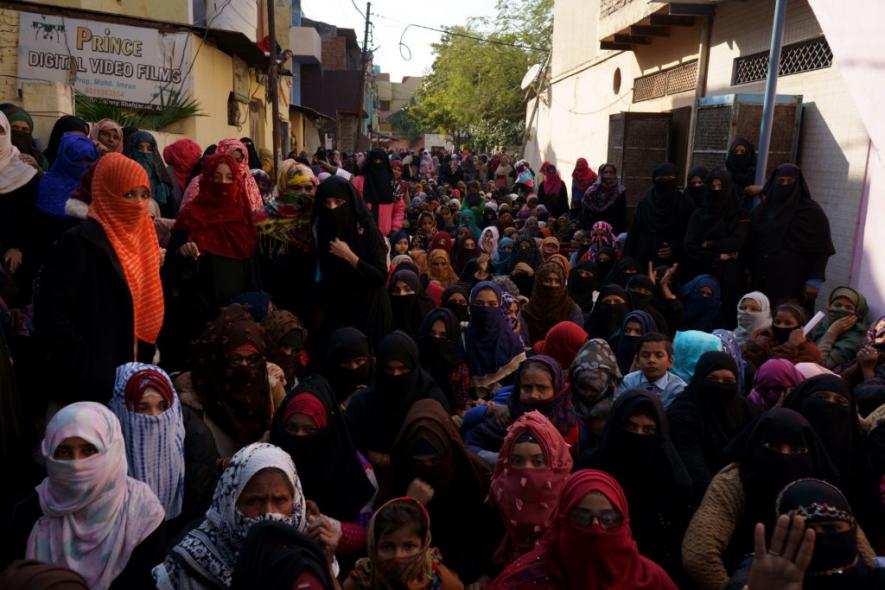
Women resisting police from entering the protest site in Shah Jamal, Aligarh. Image Courtesy: Maktoob
On Sunday afternoon, the police raided the site of an ongoing protest at the Shah Jamal locality on the outskirts of Aligarh city in Uttar Pradesh, firing tear-gas rounds and forcing a crowd, comprised mostly of women, to disperse. The violence is the culmination of a three-week-old protest at Shah Jamal against the National Population Register (NPR) and all-India National Register of Citizens (NRM).
On the intervening night of February 22-23, a large group of women staged a protest in front of the police chowki at Upper Fort in the Old City of Aligarh. On that day, the police had allegedly blocked the protester’s food supplies and disallowed them from using tarpaulin sheets and even blankets.
This protest, unlike the one in Delhi’s Shaheen Bagh, remains unknown—at least, until the violence on Sunday night. Yet, it too is spearheaded by women. They have been holding the national tricolour aloft at the gate of the New Eidgah in the Shah Jamal locality. It’s unclear what the situation after the police intervention is, but these protesters had insisted on continuing despite severe repression over the last many days.
The interesting feature of Shah Jamal protests is that it comprises the working class and daily-wage-earning Muslims of Aligarh, not its elites. The entire Shah Jamal locality consists of labourers, rickshaw pullers and small-scale entrepreneurs who make up the lowest rung of Aligarh’s social and economic life.
To the rest of Aligarh city, Shah Jamal is nothing but a backward and depressing-looking area. It was once a forested patch that surrounded the dargah (shrine) of a 14th-century Sufi saint, Shamsul Arifin Shah Jamal, and the Old Eidgah. In 1795, de Boigne, the French administrator of the Maratha ruler, Mahadji Scindia, granted this dargah two villages, named Dhorra and Jamalpur. Both these villages fall within the city’s upscale Civil Lines area and are adjacent to the Aligarh Muslim University (AMU) campus.
This dargah is registered to the Uttar Pradesh Sunni Waqf Board, “one of the richest and largest dargahs in Aligarh district”, the German scholar, Elizabeth Mann, who conducted a study of Aligarh’s Muslims in 1992, has noted. The irony is that all around this rich dargah is a settlement of Aligarh’s poorest Muslims. It is at this site that the police have used force to disperse the women protesters in the middle of the afternoon on Sunday. There were at least 2,000 women gathered at the site at any point of time.
Shah Jamal is Virtually Stateless
The State exists in this locality only in the form of a police chowki and its oppressive intrusions into everyday lives—such as the force it used to try and disband a local protest against oppressive government policies. There are no government schools or hospitals here. The ration card system barely works. These residents have been abandoned by the state, the Opposition and by the city’s elite Muslims. The social distance of its locals from the affluent classes of Aligarh is so great that they were otherwise virtually forgotten, even by AMU. Some individuals perhaps offered the women of Shah Jamal support, but it must be clandestine, for the local police had already been intensely wrathful towards these protesters.
So much so that the women protesters even refuse to talk to unknown visitors at the protest site. Their protest maintained a low-key image during the daytime, unless there is a guest speaker. It only came to life at night, after the locals were done with their work. For instance, a gardener who works in the lawns of Civil Lines mansions nearby visits the site between 11 p.m and 1 a.m. The male protesters, when these authors visited the site, are guarded too. Their accounts provide a clue into how their ongoing struggle against NPR and NRC took the turn it did on Sunday and the road ahead.
Did ‘Insiders’ Supply Information to Police?
The protesters concern is that this incident would lead to some of them being identified as important organisers. They explained that the police have already detailed information on volunteers who distribute food, blankets, tea, refreshments, etc. These volunteers are then labelled as “organisers”, providing a reason to suppress them.
A second set of male protestors, though very few in numbers, expressed pessimism that the regime will ever hear their anxieties about procuring citizenship documents. They saw the regime as patently prejudiced against Muslims. Hence, they felt, there is no point in continuing with the protest. Yet, the authors gathered that even these protesters do not really want to wrap up their protest. They wished more to mislead us—for we, too, are strangers and outsiders to Shah Jamal.
There is also a feeling that agents and informers of the police and ruling party are in their midst, trying to get them to stop “wasting time” and “return to work”. People are acutely aware that these mukhbirs (informers) offered no assurance that the NPR-NRC are harmless. Nor could they specify what documents would be required to prove citizenship.
Another unexpected development at this protest over the last few days is that the dalits, especially young women, and Sikhs, started joining in solidarity. Yet, a climate of doubt and uncertainty persists, leading to a close vigil on every visitor to the Shah Jamal’s protest. People here fear that mischief-makers will sneak in and incite violence or unlawful activities and that these would give the police a pretext for a crackdown. They fear their protest will be delegitimised before it is snuffed out.
Unprecedented Police Surveillance, Intimidation
The police force is working hard to find connections between these protesters and anyone they can label “anti-national”. Prayer leaders or Pesh Imams of the masjids are being watched closely. Dozens of un-named FIRs are lodged frequently and notices threatening punitive fines to compensate for loss of public property are being served. There is absolutely nothing to prove such “losses” as the protesters have not even set up a blockade at any significant road.
“We are making all efforts to end this protest, and a report is being sent to the Chief Minister every day. It should be considered a success of the local administration that the protest has not turned violent in any manner,” CB Singh, Aligarh District Magistrate of Aligarh, said a couple of days ago.
The Events of Sunday Afternoon
On the night of February 20, some media persons asked the protesters to wind up. Some widely-circulated Hindi dailies appear particularly hostile and are vilifying the protesters as treasonous. Meanwhile, some cautious protesters have created a virtual anti-political wall: no political leader is given space on stage.
Informally, local policemen said during our visit there, that they felt Shah Jamal’s protest was supported by AMU students, but this claim rests largely on the protesters using some creative slogans on their placards. The participants say that if at all some speakers are from AMU, they are also residents of Shah Jamal or Upper Fort.
The fact is that AMU teachers and students have steered clear of Shah Jamal. Sir Syed Ahmad Khan, the founder of AMU, may have held elite notions, but he had supported mass education. On February 13, 1886, writing in his reformist periodical, Aligarh Institute Gazette, he insisted on creating a huge fund to run schools for the disadvantaged in every village, mohalla and town and a committee to monitor progress. He had also conducted a detailed educational and socio-economic census of Aligarh.
Far from preserving this legacy, AMU has abandoned the underclass of Shah Jamal. Their physical segregation, historical oppression and vulnerability is a big reason why only Shah Jamal—and not Sir Syed Nagar, Dhorra or the Upper Fort—have erupted in protest. For this reason alone, the Muslim elites of AMU must overcome their timidness and harness their intellectual abilities and political courage to strengthen their resistance.
Aligarh Among 5 Cities Prone to Communal Violence
This was not the case during colonial times. It is communal violence that changed the settlement pattern of the city. Shah Jamal came up in the 1970s in the wake of such a violent episode. The poorest, who were even then its Muslims, fled the congested streets and small houses of the Old City to build a home around the dargah. Well into the 1990s, communal violence would periodically engulf the Old City, frightening away more Muslims to the outskirts where Hindu and Muslim neighbourhoods are less entangled.
Aligarh’s Muslims, who fall broadly into three socio-economic categories, are also spatially segregated. The Civil Lines area, comprising Sir Syed Nagar and Dhorra, houses the educated elite, who look upon their co-religionists of the Old City with a measure of contempt. The Old City or Upper Fort is home to non-elite Muslims, who mostly follow trading and occupational classes.
Shah Jamal falls in the third category. The French scholar Juliette Gallonnier has used the term “truly disadvantaged” to describe Shah Jamal’s Muslim residents. The expression was first used by the American scholar William Julius Wilson, who compared the conditions of the Black underclass—those in the ghettos who suffered race and class disadvantages and the more upwardly-mobile middle class. For instance, one of Shah Jamal’s two municipal wards is inhabited mostly by the Muslim telis (traditionally oil-pressers) and bhishtis (water-carriers). These are truly the most vulnerable Muslim communities in Aligarh.
Considering their history and circumstances, besides the courage they have mustered, Shah Jamal needs support. As more and more dalits and Sikhs joined them, it is also up to the Hindus—saffronised or not—to re-think their position on protests.
Many in Hindu Middle Class Need to Re-visit History of Protests
When in March 1974 protesting students had attacked the offices of the English daily Searchlight and Hindi daily, Pradeep, they were chastised and repressed by the state but wider society did not look upon them as anti-nationals. When angry students had desecrated the national flag and raised black flags on Independence Day during their protest against police brutalities in Patna in 1955, they were not perceived by society as “anti-national”.
Indians need to understand that popular activism arises only when an elected government, its institutions and the public sphere denies the legitimate demands of people.
Unlike the United States, India does not have a history of civil rights struggles that sought equal rights for all minorities. It is the nationalist struggle against the British which produced a secular and democratic Constitution. Now that this Constitution has been hijacked by majoritarianism, and institutions (including most of the media) have either failed or are hand-in-glove with authoritarian forces, it is the Shah Jamals and Shaheen Baghs that are fomenting popular struggles for equality and fraternity.
Despite negotiating caste, class, gender, region and myriad other fault-lines, the ongoing anti-NRC and anti-NPR struggles have already demolished the stereotype of the veiled Muslim woman as uneducated, inarticulate and conservative. These protests are a turning point in India’s history that needs to be valued. The state, its institutions and society must heed the call of the Shah Jamals across the country.
Mohammad Sajjad teaches history and Sajad Ahmad Dar is a PhD student specialising in the urban history of 20th-century Aligarh at Aligarh Muslim University. The views are personal.
Get the latest reports & analysis with people's perspective on Protests, movements & deep analytical videos, discussions of the current affairs in your Telegram app. Subscribe to NewsClick's Telegram channel & get Real-Time updates on stories, as they get published on our website.









